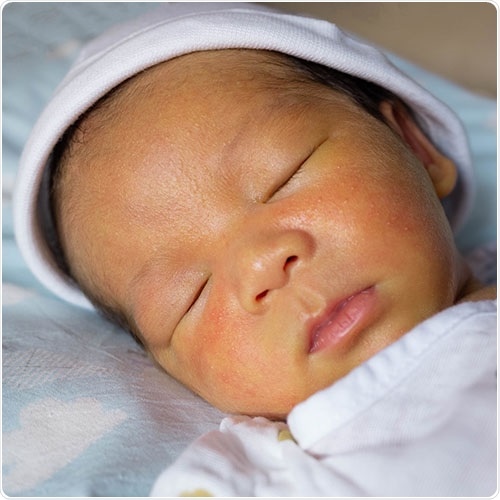Reviewed by Danielle Ellis, B.Sc.Nov 17 2021
Imagine a system that can detect within one second whether a newborn baby has jaundice, a condition affecting 60 per cent of infants, and in severe cases leading to brain damage and hearing loss.

A newborn infant with jaundice. Image Credit: University of South Australia
Visualize that system kickstarting a treatment regime immediately and notifying a nurse by text message.
Thanks to researchers from Iraq and Adelaide, all three scenarios are now possible.
Engineers from the University of South Australia and Middle Technical University have designed imaging software that can accurately diagnose jaundice in the blink of an eye, automatically turn on a blue LED light to counteract it and send the diagnosis in an SMS to the carer.
Jaundice is a common condition in newborns, especially premature babies, where there is an overload of an orange-yellow pigment called bilirubin in the bloodstream. It normally resolves quickly when the baby's liver is mature enough to remove it from the body.
However, in severe cases of jaundice, caused by sickle cell anemia, blood disorders and lack of certain enzymes, phototherapy is normally used to treat the condition, using fluorescent blue light to break down the bilirubin in the baby's skin.
UniSA remote sensing engineer Professor Javaan Chahl says jaundice is particularly prevalent in developing countries where there often isn't the equipment or trained medical staff to effectively treat it.
Using image processing techniques extracted from data captured by the camera, we can cheaply and accurately screen newborns for jaundice in a non-invasive way, before taking a blood test.
When the bilirubin levels reach a certain threshold, a microcontroller triggers blue LED phototherapy and sends details to a mobile phone.
This can be done in one second, literally, which can make all the difference in severe cases, where brain damage and hearing loss can result if treatment is not administered quickly."
Professor Javaan Chah, UniSA remote sensing engineer
Researchers tested the system in an intensive care unit in Mosul, Iraq, on 20 newborns diagnosed with jaundice. A second data set captured 16 images of newborns, five of whom were healthy, and the remainder jaundiced. The system was also successfully tested on four other manikins with white and brown skin colors, with and without jaundice pigmentation.
"Previous research using sensors to find a non-invasive way to detect jaundice has fallen short. Methods trialed have been unreliable, costly, inefficient and in some cases caused infections and allergies where sensors needed skin contact," Prof Chahl says.
"Our system overcomes these obstacles by immediately detecting jaundice based on a novel digital representation of color which allows high diagnostic accuracy at a relatively low cost. It could be widely used in hospitals worldwide and medical centres where laboratory facilities and trained medical staff are not available."
The study has been published in engineering journal Designs.
Source:
Journal reference:
Hashim, W., et al. (2021) Neonatal Jaundice Detection Using a Computer Vision System. Designs. doi.org/10.3390/designs5040063.